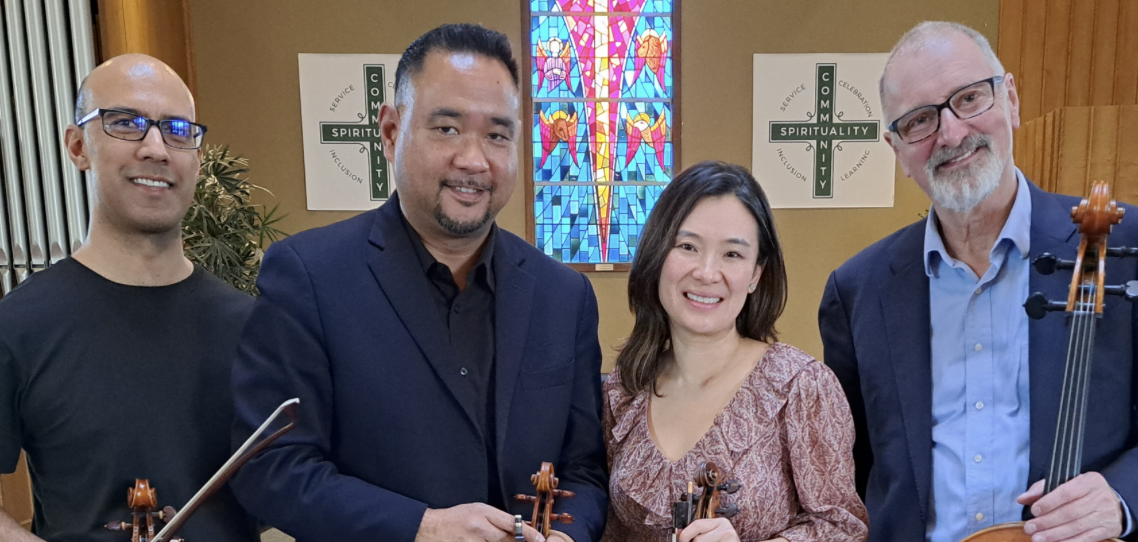|
Choral and Vocal
CANTIAMO SONOMA'S LUSCIOUS A CAPELLA SINGING IN SEASON ENDING CONCERT
by Pamela Hicks Gailey
Sunday, June 8, 2025
Symphony
SRS SEASON ENDS WITH RESOUNDING TA-TA-TA-BANG
by Terry McNeill
Sunday, June 1, 2025
Symphony
YOUTHFUL VIRTUOSITY ON DISPLAY AT USO'S MAY CONCERTS
by Peter Lert
Saturday, May 17, 2025
Symphony
MYSTICAL PLANETS AND LIVELY GERSHWIN ORTIZ AT FINAL SRS CONCERT
by Peter Lert
Sunday, May 4, 2025
Symphony
VSO'S CONCERT MUSIC OF TIME, MUSIC OF PLACE
by Peter Lert
Sunday, April 27, 2025
VOCAL ELEGANCE AND FIRE AT THE 222'S RECITAL APRIL 26
by Pamela Hicks Gailey
Saturday, April 26, 2025
CANTIAMO SONOMA SINGS AN INSPIRED GOOD FRIDAY MOZART REQUIEM CONCERT
by Pamela Hicks Gailey
Friday, April 18, 2025
DRAMATIC SHOSTAKOVICH SYMPHONY CLOSES PHILHARMONIC'S 25TH SEASON
by Terry McNeill
Sunday, April 13, 2025
LARGE COLLEGE OF MARIN AUDIENCE GREETS STOPHER ARTISTRY
by Terry McNeill
Saturday, April 5, 2025
Chamber
FRISSON DELIVERS SHIVERS OF DELIGHT
by Abby Wasserman
Sunday, March 30, 2025
|
 |
 The ASQ Nov. 12 in Marin (A. Wasserman Photo) |
"BIRD" QUARTET AT THE ALEXANDER'S CHAMBER MUSIC MARIN CONCERT
by Abby Wasserman
Sunday, November 12, 2023
The Alexander Quartet, consisting of David Samuel, viola, Zakarias Grafilo and Yuna Lee, violin, and cellist Sandy Wilson, gave Chamber Music Marin’s audience a gift November 12 with a sweep of “Russian” quartets by Haydn, Prokofiev and Shostakovich. Sponsored by Chamber Music Marin, the Bay Area ensemble performed with exquisite verve and nuance before a near-capacity audience in the Mt. Tamalpais Methodist Church.
Haydn’s delightful String Quartet in C major, Op. 33, No. 3, opened the program. Referred to as a “Russian” quartet—only because it was dedicated to the Russian Grand Duke Paul—it was innovative for its time. It’s so easy on the ears that one could underestimate its intricate architecture and the ways Haydn stretched the boundaries of the genre. Set in C major, it constantly modulates and develops its themes, passing them around generously, engaging in intimate musical conversation. Titled “The Bird,” it evokes bird song, from a single thrush on a branch to an avian brigade. Mr. Grafilo’s violin was the soprano voice for most while Ms. Lee, Mr. Samuel and Mr. Wilson colored the middle and lower voices. It was a gorgeous tapestry, with tweets, chirps and clucks woven in. While at times the mood turned dark (unusual for C major), it always reverted to sunny and warm.
The second Scherzando movement was one of Haydn’s innovations, a faster tempo than the traditional minuet. The third movement, (Adagio), is a theme and two variations that gain in complexity as they advance. The fourth movement had elements of a Slavonic folk tune, and its presto tempo made it seem as though a chorus of birds are frantically hopping from branch to branch.
The Alexander players then leapt forward 150 years to Prokofiev’s three-movement String Quartet No. 1 in B minor, Op. 50. It has an American angle, though the composer had not yet visited the U.S., and was commissioned by an American foundation and first performed at the Library of Congress. Its Allegro first movement begins at a full-out run with a tuneful and spritely motif, which quickly turns into odd sonorities and abrupt rhythmic changes. The second movement begins solemnly (morosely, actually) but soon leaps into an agitated section with quickly ascending and descending figures, pizzicato and quick, stabbing bow work, jumpy and frantic, coming finally to a sudden end.
The Andante third movement was played nostalgically and quietly, with a soaring and dipping melody by Mr. Grafilo, bolstered by a seesaw kind of perpetual motion that produced a short-lived sense of calm. Unease was signaled by Mr. Wilson’s cello line in a sober five-note motif, picked up by the others. The movement ended gently in a rocking rhythm and a final plucked note by cello and viola before silence descended.
After intermission the Quartet performed Shostakovich’s A Major Second Quartet, and the electricity of this 1944 work was palpable. As most of his string quartets, this one suggests a vivid personal statement. Highly energetic, with unusual sonorities and a taut construction, it is an odyssey, a coming home from a faraway place. The opening Overture was played as an undulating cry.
In the second movement a plaintive Jewish melody performed by Mr. Grafilo rose above a hymn-like drone, then turned into a lyrical but bittersweet Romance section suggesting lost love, with Ms. Lee, Mr. Samuels and Mr. Wilson, always stellar in ensemble, blending their instrumental voices in beautiful descending phrases. The Recitative theme returned briefly followed by a curiosity: three forte plucked chords from the cello seemed to stop time. And indeed, the movement soon ended.
The third movement (Valse) was played with mystery. Disembodied voices seemed to rise and fall, and the waltz tempo slows and quickens and becomes frantic and agitated. There are ghostly slurs and chromatics. The music had a danse macabre effect. Movement four (Theme and Variation: Adagio) presented a lovely theme with variations that start out with simplicity and become increasingly complex. At every moment in this work the Alexander’s interpretation expressed the humanity and near divinity of this great music.
A prolonged standing ovation demonstrated the audience’s gratitude.
|

